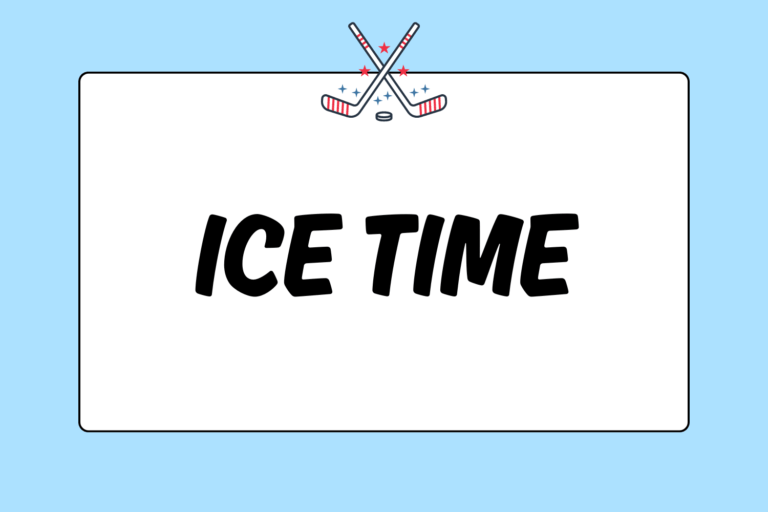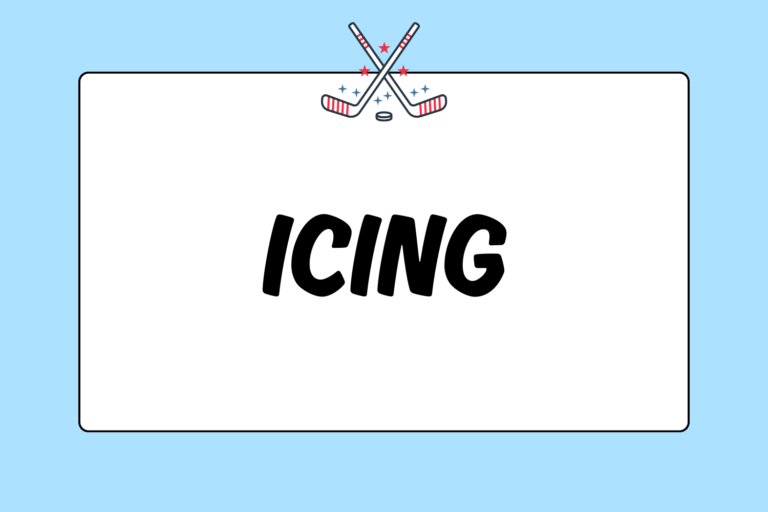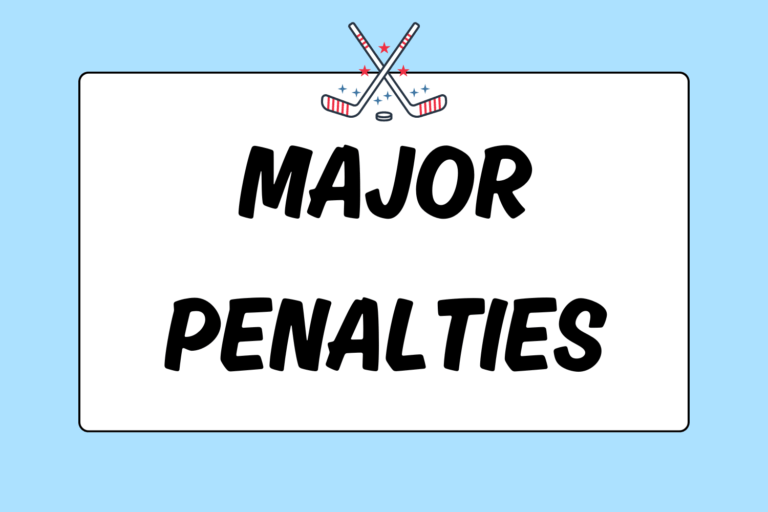A
Assist – The pass or last two passes made before a player on the same team scores a goal.
Attacking zone – The area from the blue line to the boards that contains the opponent’s goal.
B
Backchecking – When a player skates back toward his defensive zone to disrupt an opposing player who is trying to help his team score.
Backhand shot – When a right-handed player shoots with the right side of his stick blade or a left-handed player shoots with the left side of his stick blade.
Biscuit in the basket – Nickname for a goal.
Blind pass – To pass the puck without looking ahead or choosing a distinct target.
Blow a tire – When a player falls as a result of their own actions (for example, not being checked).
Blue line – The two one-foot lines that run along the width of the ice and determine the beginning of each team’s zone.
Boarding – A penalty that occurs when a player attempts to violently push or throw a player into the boards.
Boards – The oval-shaped wooden wall that borders the rink and has Plexiglass fitted on top of it to keep the puck in play.
Body check – The act of using the shoulder or hip to take an opposing player out of position when he has possession of the puck.
Break – A rush in which the opposing team has players caught out of position.
Breakaway – When a player is moving into the attacking zone with possession of the puck and no one between him and the opposing goalie.
Breakout – A very basic, very effective set play that a team uses to clear the puck from its defensive zone.
Breezers – Nickname for protective ice hockey pants.
Butt-ending – A major penalty that involves a player hitting an opponent with the top part of the stick’s shaft.
C
Center – An offensive position where the player has freedom to roam virtually anywhere on the ice and takes the majority of the faceoffs.
Centering pass – When a player passes to a teammate who is in front of the goal, in position to score.
Changing on the fly – The act of making a player substitution while the play is in progress.
Charging – A penalty called when a player clearly takes two or more steps in attempt to generate greater impact for a body check.
Cherry picking – Rather than skating down to the defensive side of the ice to play defense, an offensive player stays back near the offensive zone; waiting for a chance to get the puck and score.
Chippy – An adjective indicating aggressive play.
Cross check – A minor penalty called when a player has his hands spread apart on his stick and hits an opponent with the exposed part of the stick’s shaft.
Crossbar – The metal bar that connects the top of the two goalposts.
D
Dangle – Nickname for a deke.
Defensemen – A position in hockey; each team has two players in this position on the ice at one time, patrolling the area closest to their team’s goalie and rarely going deep into the offensive end.
Defensive zone – The area from the blue line to the boards that contains your team’s goal.
Deke – An action that is meant to fool a defensive player; the puck carrier fakes like he is going in one direction only to actually go in a different direction.
Delay of game – A minor penalty that is called when a player purposely delays the flow of the game.
Delayed penalty – The time between when a referee raises his hand to signal a penalty and when he actually blows the whistle to stop play and send a player to the penalty box.
Double minor – When a minor penalty becomes worse due to injury or an intent to injure. For this, the player must serve four minutes in the penalty box instead of the regular two-minute penalty.
Drop pass – When a player simply leaves the puck in a stationary position with the idea that a trailing teammate will gain possession.
Dropping the mitts – A nickname for fighting.
E
Elbowing – A minor penalty that occurs when a player uses his elbow to hit an opponent.
Empty-net goal – A goal that is scored against a team that has chosen to pull its goalie in exchange for another skater.
Endboards – The boards behind the goals at each end of the rink.
Enforcer – A player whose primary job is to be tough and provide physical support for his team’s top players.
F
Face-off – The act that initiates the start of a game, period or any play following a whistle; it features a player from each team battling for possession after the referee or linesman drops the puck on the ice.
Face-off circle – A circle that measures 30 feet in diameter and surrounds each of the five face-off dots on the ice.
Fighting – A major penalty that is called when players on opposing teams square off and exchange punches.
Five hole – The area between the leg pads of a goalie that players often target when trying to score a goal.
Flip shot – A type of shot when a player tries to get the blade of his stick underneath the puck and loft it toward the goal in hopes that it will bounce or get deflected into the net.
Forechecking – When a player checks or pressures the opposing team while it possesses the puck in its defensive zone.
Forehand – A shot or pass that comes off the inside part of the stick’s blade.
Forwards – The three offensive players (the center and two wingers) on the ice at one time for each team and attack the opposition’s goal.
Full strength – When a team plays the maximum six players on the ice at a time.
G
Gate – Nickname for the penalty box.
Goal – The term used to describe the netted object bordered with metal posts that acts as a target for the puck of the opposing team; it is positioned along each goal line in the center of the ice; when the puck crosses the goal line between the metal posts, the attacking team is awarded one point.
Goal crease – The painted, half-circle shaped area in front of the goal that marks the zone only the goaltender is permitted to occupy.
Goal line – The two-inch thick red lines that run from boards to boards 11 feet off each end of the rink.
Goalposts – The metal bars that define the outer edge of the netted targets (goals) that are stationed at each end of the rink along the goal line.
Goaltender – The one player on each team who can stand directly in front of and in the goal in an effort to prevent the puck from going between the goal posts and across the goal line; they are also allowed to wear larger pads than anyone else on the ice.
Gordie Howe hat trick – When a player scores a goal, records an assist, and gets into a fight in a single game.
H
Hat Trick – When a player scores three goals in one game.
High-sticking – A minor penalty that occurs when a player raises his stick above an opponent’s shoulders and strikes him with the stick.
Holding – A minor penalty that occurs when a player attempts to impede an opponent’s progress by grabbing him with his hands or arms.
Hooking – A minor penalty that occurs when a player uses the blade of his stick to slow or impede an opponent.
I
Icing – A violation that occurs when a player sends the puck across the center red line, into the opposition’s zone and across the goal line without giving an opposing player a chance to impede its motion. A stoppage of play comes when this happens and the ensuing faceoff takes place in the defensive zone of the team which committed the violation.
Interference – A minor penalty that occurs when a player disrupts an opponent who doesn’t have possession of the puck.
K
Kneeing – A minor penalty that occurs when a player strikes an opponent with his knee.
L
Light the lamp – To score a goal.
Line change – When all the forwards or defensemen on one team are replaced on the ice by a new unit; usually occurs during a stoppage of play.
Linesmen – Officials who won’t call penalties or signal goals, but instead are in charge of making sure the line rules such as icing or offsides are being obeyed. They also conduct face-offs.
Lumber – Nickname for a hockey stick.
M
Major penalty – A more serious penalty that calls for a player to sit in the penalty box while his team is minus one man for five minutes.
Minor penalty – A penalty that calls for a player to sit and his team to be minus one man for two minutes.
N
Natural Hat Trick – When a player scores three goals in a game without interruption of any goal by a teammate or opposing player.
Net – The portion of the goal that covers the back end and acts as a backstop for pucks that go between the two goal posts and across the goal line.
Neutral zone – The area on the ice between the two blue lines.
O
Officials – The team of referees and linesmen who police the ice, keep the peace between teams and make the calls on goals, penalties and other infractions.
Offside – A violation that occurs when both skates of a player cross the blue line and into the opposition’s zone before the puck. This violation also occurs when the puck leaves the offensive zone and then goes back across the same blue line before all members of the attacking team were able to clear the zone. This results in a stoppage of play and an ensuing faceoff on one of the circles just outside of the zone where the infraction was committed.
Open ice – Part of the ice that is not occupied by any opposing players.
Overtime – An additional period added on to the end of a game to break a tie.
P
Pass – The act of a player using his stick to push the puck along to a teammate.
Penalty – The punishment for a team when one of its players commits an infraction. The player that commits the infraction is suspended anywhere from two minutes to the amount of time remaining in the game.
Penalty box – A small area on the other side of the boards where a player who commits a penalty must serve his suspension.
Penalty kill – When a team is trying to survive a situation of being down one or two men because of penalties.
Penalty shot – Widely considered the most exciting play in hockey; it is a free shot on goal awarded to a team who had a player illegally brought down while on a breakaway or had a scoring opportunity disrupted by an opposing player. The play is in breakaway form with only a skater from the team awarded the shot against the opposing goalie.
Periods – The three intervals of time in which a game is divided.
Point – A statistic awarded to any player who either scores or assists on a goal; also a nickname used for the area near the blue line that the defenseman occupy while in the attacking zone.
Poke check – When a player uses his stick to try to separate the puck from an opponent’s stick.
Power Play – The advantage a team gets when an opposing player commits a penalty and forces his team to play one man down.
Puck – The solid rubber disc that the players attempt to send into the opposition’s goal to gain points. It is one inch thick, three inches in diameter and weighs around six ounces.
Pull the goalie – An act that usually occurs in the closing minutes of a game, the team that is losing will put a sixth skater on the ice in exchange for its goalie in attempt to generate a final offensive push.
R
Rebound – When the puck bounces off the goalie and back out in front of the net.
Red line – The one-foot wide line that divides the ice in half and runs from boards to boards.
Referee – The lead official who is in charge of making all of the calls regarding goals, penalties and any other major decisions that affect the outcome of a game.
Rink – The surface of ice surrounded by boards and glass on which the game is played. In the NHL, the rinks are 200 feet long and 85 feet wide. In international competition, rinks are 200 feet long and 100 feet wide.
Rink rat – A hockey player who is constantly around the rink. Often a young player who spends hours a day playing hockey.
Roughing – A minor penalty that occurs when a player illegally pushes or shoves an opponent.
S
Saucer pass – A pass that comes just high enough off the ice so that it goes over an opposing player’s stick and onto that of a teammate.
Save – When a goalie uses any part of his body, stick or equipment to stop the puck from going into the goal.
Screen – When a player stations himself in front of the opposing goalie in attempt to block the goalie’s view of the puck and play in front of him.
Shorthanded – When one or two players on the same team commit penalties and force their team to play with less than six players on the ice.
Shot on goal – A shot from a player that either goes into the goal or is stopped by the goalie.
Shutout – When a team holds the opposition scoreless through an entire game.
Sideboards – The boards that run along the length of the ice.
Sieve – A goalie who lets in many goals.
Sin Bin – A nickname for the penalty box.
Slapshot – The shooting motion that generates the greatest velocity; occurs when the player raises his stick off the ice and behind his body, and then comes down with the blade of his stick hitting the ice and the puck simultaneously.
Slashing – A minor penalty that occurs when a player attempts to use his stick to hit an opponent.
Slewfoot – When a player uses his skate to sweep out the skate of another player; usually considered one of the dirtiest plays in the game.
Slot – The immediate area in front of the net.
Snap shot – A shot that comes with the least amount of motion by the shooter and results in the quickest and sneakiest release of the puck; occurs when the player pulls the stick back and snaps his wrists upon contact with a stationary puck.
Stickhandle – The act of a player using his stick to swiftly move the puck back and forth in an attempt to fool an opponent and keep possession of the puck.
Sudden-death overtime – An overtime period that ends with a goal, which will then signify the end of the game.
T
Top shelf – The upper section of the goal.
Trailer – A player who is behind his teammates during a rush into the offensive zone and awaits a regular pass or drop pass.
Tripping – A minor penalty that occurs when a player uses his stick, skates, or any part of his leg to take an opponent down.
Twig – Nickname for a hockey stick.
Two-line pass – A pass after which an official will whistle the play dead because it illegally left a player’s stick, traveled over one of the blue lines and the center red line and into the possession of a teammate.
W
Waffle board – Also called a blocker, it is a flat, rectangular-shaped pad that the goaltender wears on his arm in order to block the puck.
Wrist shot – A shot that is by far the most accurate; occurs when the player pulls the puck back, leaves the blade of his stick on the ice, and releases the puck with a motion that involves both a flick of the wrist and a push with the forearms.
Z
Zamboni – The machine that is used to resurface the ice after games and between periods.
Zebra – Nickname for a referee.





